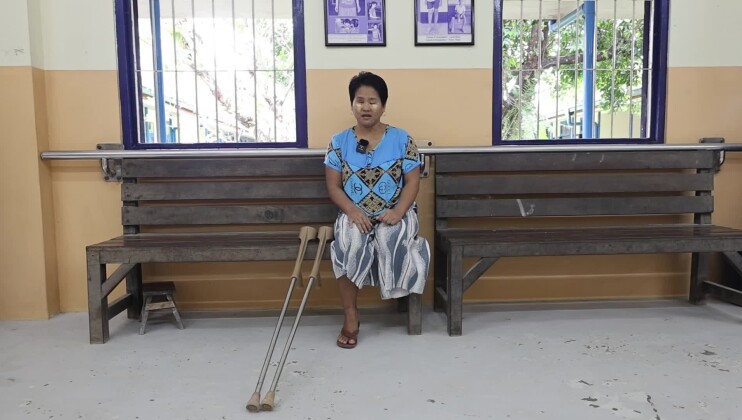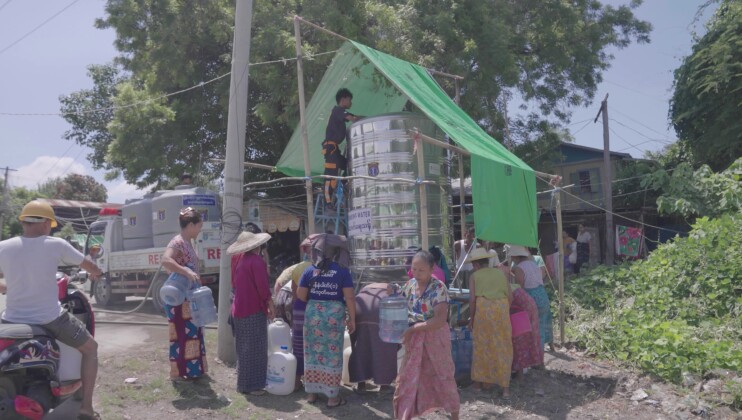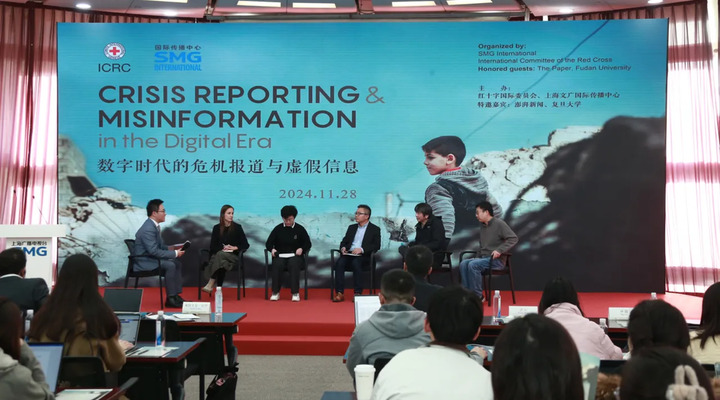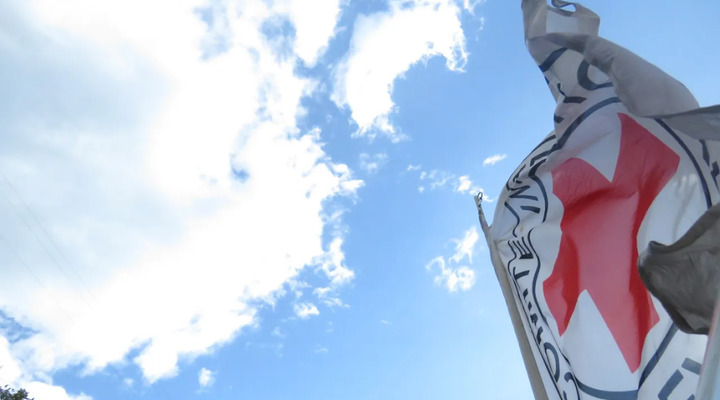Philippines: Communities displaced in Zamboanga
More than nine months after the fighting stopped between government forces and Muslim rebels from a Moro National Liberation Front (MNLF) faction in Zamboanga, south west Philippines, 40,000 people are still unable to return home.
Instead, they are trying to survive either in overcrowded in ad hoc evacuation centres such as a sports stadium or they are squatting by the shoreline.
For many, their homes were burnt and completely destroyed during the fighting leaving them dependent on humanitarian assistance
Victor Haliddan from Rio Hondo never thought that his house would be destroyed as the fighting was in another village: “We never imagined the violence would intensify. I told my children that Sta. Barbara (village) is far from us. But the fire still reached our house.”
Before the conflict, Victor Haliddan was able to send all six of his children to school with his modest income from driving a tricycle around the city. His wife also used to earn income from the small variety store by their house in Rio Hondo.
Now living as internally displaced persons (IDPs) by the Cawa-Cawa shoreline under difficult conditions, income is hard to come by having lost their livelihood. His family received a cash grant from ICRC which they used to start up a small variety store, but more than anything, what they really want is to be able to return to their village. “For me, it is okay not to receive any assistance as long as we are allowed to go back to our place.”
During the fighting, Dora and her family left their village in haste, leaving their home and belongings behind. While at the evacuation centre in Talon-Talon village, they were completely dependent on relief after their only source of income – seaweed farming – was destroyed during the conflict. With nothing left, she had no idea how to start over.
While they have slowly managed to restore their livelihood after receiving a cash grant from ICRC, Dora’s family doesn’t want to be relocated far from their farm and the children’s school because they can’t afford the transport: “What else will we give them for lunch money when it’s all spent on fare?”
“Progress has been somewhat slow in achieving a durable solution, relocating the displaced population to suitable housing that will eventually lead to a more permanent solution, and so the needs are still very much present,” said Gareth Gleed, the delegate in charge of the operations in Zamboanga.
In cooperation with the Philippine Red Cross, ICRC continues to respond to the needs of the displaced population, addressing the long-term sanitation and water supply in the different evacuation centres, and strengthening their resilience through cash-for-work schemes and unconditional cash grants.
ICRC is also refurbishing health stations damaged in the fighting and providing medicines, other supplies and technical and financial support to the local health authorities and the Zamboanga City Medical Center.
In May, the ICRC set up a nutrition programme for malnourished children under five years of age and for pregnant and lactating women with a view to reducing the number of preventable deaths. So far 225 children and 32 women are being followed under this programme. In addition, multipurpose halls are being built in three evacuation centres to carry out hygiene promotion, nutrition and health-care activities.
“People have not been able to return to their traditional livelihood. They still suffer from the loss of their housing and their belongings and so there still is a very very high level of vulnerability amongst a population that was already quite vulnerable to begin with,” stressed Gareth Gleed.
Shotlist
Location: Zamboanga City, Philippines
(Joaquin Enriquez stadium, Cawa-Cawa shoreline, Talon-Talon evacuation center)
Length: 10:32
Format: HD
Production: Sarah Jane Velasco
Camera: M R Hasan, Albert Madrazo
Sound: English, Tagalog
ICRC ref: AV195N
Date: 2014
0:00 Busy street in Zamboanga City
0:05 People walking in front of Zamboanga City Hall
0:10 Panning shot of Joaquin Enriquez Stadium, overview
0:19 Various living conditions of IDPs inside the stadium
0:32 Internally displaced persons (IDPs) living in tents at the Cawa-Cawa shoreline
0:43 Burnt houses and scenes of devastation in Rio Hondo
0:57 CU of bullet-riddled KJK building
SOUNDBITE Victor Haliddan, IDP and cash grant recipient, Cawa-Cawa shoreline (in Tagalog):
1:01 We did not take anything with us when we evacuated. We never imagined the violence would intensify. I told my children that Sta. Barbara is far from us. But it turned out that the fire still reached our house. The fighting never happened in our place but many houses were burned down.
1:21 I used to be a driver at the port area. That was where I used to drive and also in Zamboanga City. My wife has her own variety store. All my six children were studying then.
1:39 Boats, row of houses on stilts at the Cawa-Cawa shoreline
1:42 Boats at sea
1:50 Victor Haliddan’s wife in their variety store in Cawa-Cawa, selling to customers
SOUNDBITE Victor Haliddan, IDP and cash grant recipient, Cawa-Cawa shoreline (in Tagalog):
2:07 We have been here for nine months and we have no idea until when we are staying here. They have not set a date but we are just waiting. If they tell us to leave, we cannot do anything but follow. But we are hoping to return home soon.
2:30 Victor fetching water from a tap stand in Cawa-Cawa shoreline
SOUNDBITE Victor Haliddan, IDP and cash grant recipient, Cawa-Cawa shoreline (in Tagalog):
3:02 Finding income here is difficult.
03:06 When Red Cross came, we received PHP 8,800 and used it to start up this variety store. We let the business flourish.
03:18 It is really hard to sleep even if it is not a warm season. You are deprived of a good sleep where you cannot hear anything.
3:27 Panning inside a tent in Cawa-Cawa shoreline, with IDP family belongings
3:33 Long shot of Victor Haliddan’s variety store from across the street with vehicles passing
SOUNDBITE Victor Haliddan, IDP and cash grant recipient, Cawa-Cawa shoreline (in Tagalog):
3:46 It is really painful and difficult. It seems like we are waiting for nothing.
3:53 For me, it is okay not to receive any assistance as long as we are allowed to go back to our place.
SOUNDBITE Dora Kasim, IDP and cash grant recipient, Talon-Talon evacuation centre (in Tagalog):
4:01 We rode a boat, leaving all our belongings because the boat was small. As long as all the children were there, it didn’t matter if the rest of the things were left.
4:13 Boy playing with an old tire in Talon-Talon evacuation centre
4:19 Dora Kasim and her family inside the classroom turned into an evacuation centre, preparing straws used in seaweed farming
4:24 CU of Dora’s face
4:28 CU of Dora’s hands while preparing straws
4:34 Top shot of Dora’s daughter sleeping on a hammock
4:39 Dora and husband preparing straws
4:44 CU of Dora’s husband’s face
SOUNDBITE Dora Kasim, IDP and cash grant recipient, Talon-Talon evacuation centre (in Tagalog):
4:48 It was painful. I was in a daze, couldn’t say much. I asked my husband what we were going to do, where do we start, how will our life be, are we just going to rely on supplies?
5:14 Dora’s husband and son leaving the evacuation centre
5:29 Pushing boat, heading out to the seaweed farm
SOUNDBITE Dora Kasim, IDP and cash grant recipient, Talon-Talon evacuation centre (in Tagalog):
5:51 We are happy that we now have a boat, an alol (seaweed farm) and agar-agar from the help received from Red Cross.
5:59 They said we’ll be transferred to Mampang but if we go there, it will be more difficult because it’s far. If we go to Layag-Layag from there, the current is too strong for a paddle boat.
6:25 And when the children go to school, they need to commute every day. What else will we give them for lunch money when it’s all spent on fare?
6:35 CU of Dora’s son’s hand with straw, on a boat
6:40 Dora’s husband and son returning from the sea
SOUNDBITE Gareth Gleed, ICRC delegate in Zamboanga (in English):
6:58 I think it’s very important to highlight that even though the conflict was some 8 months ago, the displaced population still remains very much victims of this conflict. The process of relocating to transitory sites which will eventually lead to their return to their areas of origin has been somewhat slow requiring sustained response on behalf of the ICRC.
7:24 Stadium shot with ICRC land cruiser set against bleachers with semi-permanent structures
7:28 Panning shot of stadium, from different angle
7:31 Stadium alley with people walking
SOUNDBITE Gareth Gleed, ICRC delegate in Zamboanga (in English):
7:36 The activities that we’re implementing are very much a continuation of the emergency services we provided during the conflict itself. For example, the cash-for-work programs have been continued in order to essentially maintain a rough level of sanitation and the cleanliness of different sites where the displaced population find themselves.
7:57 Water tap stand with people lining up to fetch water, stadium
8:04 CU of water flowing from tap stand
8:08 Water tap stand with people lining up to fetch water, stadium
8:14 Cash-for-work beneficiaries cleaning the canal
SOUNDBITE Gareth Gleed, ICRC delegate in Zamboanga (in English):
8:24 It was recognized fairly early on that especially for children under the age of 5 and pregnant and lactating women that they were having difficulty in meeting their basic dietary needs. There have been a number of deaths that were potentially avoidable if proper nutrition have been provided. So the ICRC has, in cooperation with the City Health Office, has installed two feeding centres – one in the stadium here and one in another evacuation centre called Cawa-Cawa just outside the stadium where we are attempting to identify and provide nutritional supplements to children under 5 and pregnant and lactating women.
9:03 Inside the nutrition tent, mothers enrolling children in the nutrition program
9:10 Weighing of malnourished child
9:16 Measuring height of malnourished child
9:20 Measuring arm of malnourished child
(:24 Disinfecting the hand of malnourished child prior to feeding
9:27 Malnourished child drinking water, eating supplementary food
9:33 CU of child eating supplementary food
9:39 Malnourished pregnant woman receiving supplementary food
9:43 Measuring the arm of malnourished pregnant woman
SOUNDBITE Gareth Gleed, ICRC delegate in Zamboanga (in English):
9:48 As I’ve mentioned progress has been somewhat slow in achieving a durable solution, relocating the displaced population to suitable housing that will eventually lead to a more permanent solution, and so the needs are still very much present.
10:03 Old man cutting wood, stadium
10:06 Men building a tent inside the stadium
10:09 Panning of an IDP tent beside garbage bins
10:14 Father and daughter at sea
SOUNDBITE Gareth Gleed, ICRC delegate in Zamboanga (in English):
10:18 People have not been able to return to their traditional livelihood. They still suffer from the loss of their housing and their belongings and so there still is a very very high level of vulnerability amongst a population that was already quite vulnerable to begin with.
END



